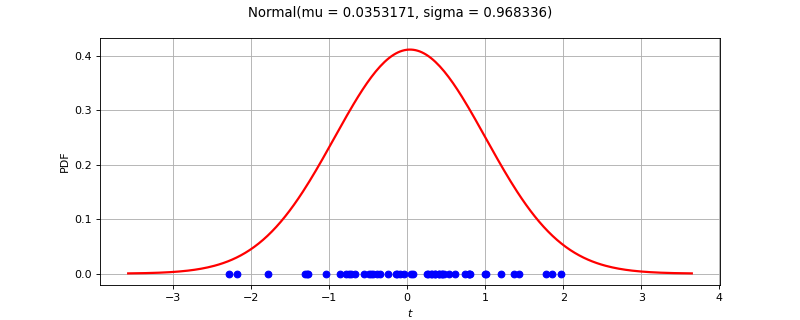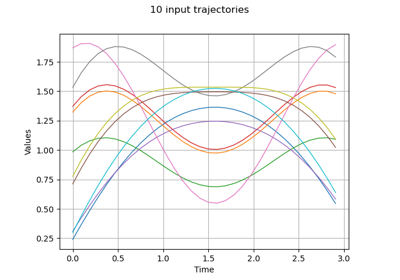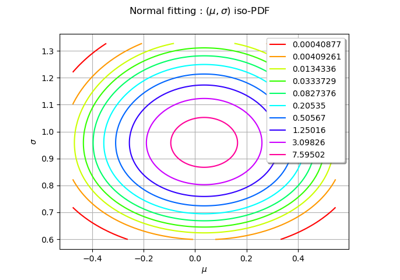NormalFactory¶
(Source code, png)

- class NormalFactory(*args)¶
Normal factory.
- Available constructors:
NormalFactory(robust=False)
- Parameters:
- robustbool, optional
Flag to select robust estimators of the parameters
See also
Notes
The parameters are estimated by likelihood maximization if robust=False:
If robust=True, the estimation is done using the empirical median
as an estimate of
, the empirical inter-quartile
as an estimate of the standard deviation, where
and
are the 75% and 25% quantiles of the standard normal distribution, and the correlation matrix
is estimated as the shape matrix of the underlying
NormalCopulausingNormalCopulaFactory.Examples
In the following example, the parameters of a
Normalare estimated from a sample.>>> import openturns as ot >>> ot.RandomGenerator.SetSeed(0) >>> size = 10000 >>> distribution = ot.Normal(1.0, 2.0) >>> sample = distribution.getSample(size) >>> factory = ot.NormalFactory() >>> estimated = factory.build(sample)
Methods
build(*args)Build the distribution.
buildAsNormal(*args)Estimate the distribution as native distribution.
buildEstimator(sample)Build the distribution and the parameter distribution.
Accessor to the bootstrap size.
Accessor to the object's name.
getId()Accessor to the object's id.
getName()Accessor to the object's name.
Accessor to the object's shadowed id.
Accessor to the object's visibility state.
hasName()Test if the object is named.
Test if the object has a distinguishable name.
setBootstrapSize(bootstrapSize)Accessor to the bootstrap size.
setName(name)Accessor to the object's name.
setShadowedId(id)Accessor to the object's shadowed id.
setVisibility(visible)Accessor to the object's visibility state.
- __init__(*args)¶
- build(*args)¶
Build the distribution.
Available usages:
build(sample)
build(param)
- Parameters:
- sample2-d sequence of float
Sample from which the distribution parameters are estimated.
- paramCollection of
PointWithDescription A vector of parameters of the distribution.
- Returns:
- dist
Distribution The built distribution.
- dist
- buildAsNormal(*args)¶
Estimate the distribution as native distribution.
- buildEstimator(sample)¶
Build the distribution and the parameter distribution.
- Parameters:
- sample2-d sequence of float
Sample from which the distribution parameters are estimated.
- parameters
DistributionParameters Optional, the parametrization.
- Returns:
- resDist
DistributionFactoryResult The results.
- resDist
Notes
According to the way the native parameters of the distribution are estimated, the parameters distribution differs:
Moments method: the asymptotic parameters distribution is normal and estimated by Bootstrap on the initial data;
Maximum likelihood method with a regular model: the asymptotic parameters distribution is normal and its covariance matrix is the inverse Fisher information matrix;
Other methods: the asymptotic parameters distribution is estimated by Bootstrap on the initial data and kernel fitting (see
KernelSmoothing).
If another set of parameters is specified, the native parameters distribution is first estimated and the new distribution is determined from it:
if the native parameters distribution is normal and the transformation regular at the estimated parameters values: the asymptotic parameters distribution is normal and its covariance matrix determined from the inverse Fisher information matrix of the native parameters and the transformation;
in the other cases, the asymptotic parameters distribution is estimated by Bootstrap on the initial data and kernel fitting.
- getBootstrapSize()¶
Accessor to the bootstrap size.
- Returns:
- sizeinteger
Size of the bootstrap.
- getClassName()¶
Accessor to the object’s name.
- Returns:
- class_namestr
The object class name (object.__class__.__name__).
- getId()¶
Accessor to the object’s id.
- Returns:
- idint
Internal unique identifier.
- getName()¶
Accessor to the object’s name.
- Returns:
- namestr
The name of the object.
- getShadowedId()¶
Accessor to the object’s shadowed id.
- Returns:
- idint
Internal unique identifier.
- getVisibility()¶
Accessor to the object’s visibility state.
- Returns:
- visiblebool
Visibility flag.
- hasName()¶
Test if the object is named.
- Returns:
- hasNamebool
True if the name is not empty.
- hasVisibleName()¶
Test if the object has a distinguishable name.
- Returns:
- hasVisibleNamebool
True if the name is not empty and not the default one.
- setBootstrapSize(bootstrapSize)¶
Accessor to the bootstrap size.
- Parameters:
- sizeinteger
Size of the bootstrap.
- setName(name)¶
Accessor to the object’s name.
- Parameters:
- namestr
The name of the object.
- setShadowedId(id)¶
Accessor to the object’s shadowed id.
- Parameters:
- idint
Internal unique identifier.
- setVisibility(visible)¶
Accessor to the object’s visibility state.
- Parameters:
- visiblebool
Visibility flag.
Examples using the class¶

Estimate Sobol indices on a field to point function
 OpenTURNS
OpenTURNS


